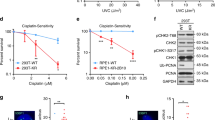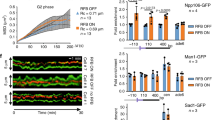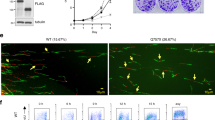Abstract
Damaged DNA, if not repaired before replication, can lead to replication fork stalling and genomic instability1,2,3; however, cells can switch to different damage bypass modes that permit replication across lesions. Two main bypasses are controlled by ubiquitin modification of proliferating cell nuclear antigen (PCNA), a homotrimeric DNA-encircling protein that functions as a polymerase processivity factor and regulator of replication-linked functions4,5. Upon DNA damage, PCNA is modified at the conserved lysine residue 164 by either mono-ubiquitin or a lysine-63-linked multi-ubiquitin chain5, which induce error-prone or error-free replication bypasses of the lesions5,6. In S phase, even in the absence of exogenous DNA damage, yeast PCNA can be alternatively modified by the small ubiquitin-related modifier protein SUMO5; however the consequences of this remain controversial5,6,7. Here we show by genetic analysis that SUMO-modified PCNA functionally cooperates with Srs2, a helicase that blocks recombinational repair by disrupting Rad51 nucleoprotein filaments8,9. Moreover, Srs2 displays a preference for interacting directly with the SUMO-modified form of PCNA, owing to a specific binding site in its carboxy-terminal tail. Our finding suggests a model in which SUMO-modified PCNA recruits Srs2 in S phase in order to prevent unwanted recombination events of replicating chromosomes.
This is a preview of subscription content, access via your institution
Access options
Subscribe to this journal
Receive 51 print issues and online access
$199.00 per year
only $3.90 per issue
Buy this article
- Purchase on Springer Link
- Instant access to full article PDF
Prices may be subject to local taxes which are calculated during checkout




Similar content being viewed by others
References
Barbour, L. & Xiao, W. Regulation of alternative replication bypass pathways at stalled replication forks and its effects on genome stability: a yeast model. Mutat. Res. 532, 137–155 (2003)
Smirnova, M. & Klein, H. L. Role of the error-free damage bypass postreplication repair pathway in the maintenance of genomic stability. Mutat. Res. 532, 117–135 (2003)
Osborn, A. J., Elledge, S. J. & Zou, L. Checking on the fork: the DNA-replication stress-response pathway. Trends Cell Biol. 12, 509–516 (2002)
Tsurimoto, T. PCNA binding proteins. Front. Biosci. 4, D849–D858 (1999)
Hoege, C., Pfander, B., Moldovan, G. L., Pyrowolakis, G. & Jentsch, S. RAD6-dependent DNA repair is linked to modification of PCNA by ubiquitin and SUMO. Nature 419, 135–141 (2002)
Stelter, P. & Ulrich, H. D. Control of spontaneous and damage-induced mutagenesis by SUMO and ubiquitin conjugation. Nature 425, 188–191 (2003)
Haracska, L., Torres-Ramos, C. A., Johnson, R. E., Prakash, S. & Prakash, L. Opposing effects of ubiquitin conjugation and SUMO modification of PCNA on replicational bypass of DNA lesions in Saccharomyces cerevisiae . Mol. Cell. Biol. 24, 4267–4274 (2004)
Veaute, X. et al. The Srs2 helicase prevents recombination by disrupting Rad51 nucleoprotein filaments. Nature 423, 309–312 (2003)
Krejci, L. et al. DNA helicase Srs2 disrupts the Rad51 presynaptic filament. Nature 423, 305–309 (2003)
Johnson, E. S. & Blobel, G. Cell cycle-regulated attachment of the ubiquitin-related protein SUMO to the yeast septins. J. Cell Biol. 147, 981–994 (1999)
Bernier-Villamor, V., Sampson, D. A., Matunis, M. J. & Lima, C. D. Structural basis for E2-mediated SUMO conjugation revealed by a complex between ubiquitin-conjugating enzyme Ubc9 and RanGAP1. Cell 108, 345–356 (2002)
Johnson, E. S. & Gupta, A. A. An E3-like factor that promotes SUMO conjugation to the yeast septins. Cell 106, 735–744 (2001)
Kannouche, P. L., Wing, J. & Lehmann, A. R. Interaction of human DNA polymerase η with monoubiquitinated PCNA: a possible mechanism for the polymerase switch in response to DNA damage. Mol. Cell 14, 491–500 (2004)
Watanabe, K. et al. Rad18 guides poleta to replication stalling sites through physical interaction and PCNA monoubiquitination. EMBO J. 23, 3886–3896 (2004)
Symington, L. S. Role of RAD52 epistasis group genes in homologous recombination and double-strand break repair. Microbiol. Mol. Biol. Rev. 66, 630–670 (2002)
Aylon, Y. & Kupiec, M. New insights into the mechanism of homologous recombination in yeast. Mutat. Res. 566, 231–248 (2004)
Lawrence, C. W. & Christensen, R. B. Metabolic suppressors of trimethoprim and ultraviolet light sensitivities of Saccharomyces cerevisiae rad6 mutants. J. Bacteriol. 139, 866–887 (1979)
Aboussekhra, A. et al. RADH, a gene of Saccharomyces cerevisiae encoding a putative DNA helicase involved in DNA repair. Characteristics of radH mutants and sequence of the gene. Nucleic Acids Res. 17, 7211–7219 (1989)
Schiestl, R. H., Prakash, S. & Prakash, L. The SRS2 suppressor of rad6 mutations of Saccharomyces cerevisiae acts by channeling DNA lesions into the RAD52 DNA repair pathway. Genetics 124, 817–831 (1990)
Palladino, F. & Klein, H. L. Analysis of mitotic and meiotic defects in Saccharomyces cerevisiae SRS2 DNA helicase mutants. Genetics 132, 23–37 (1992)
Ulrich, H. D. The srs2 suppressor of UV sensitivity acts specifically on the RAD5- and MMS2-dependent branch of the RAD6 pathway. Nucleic Acids Res. 29, 3487–3494 (2001)
Broomfield, S. & Xiao, W. Suppression of genetic defects within the RAD6 pathway by srs2 is specific for error-free post-replication repair but not for damage-induced mutagenesis. Nucleic Acids Res. 30, 732–739 (2002)
Soustelle, C. et al. A new Saccharomyces cerevisiae strain with a mutant Smt3-deconjugating Ulp1 protein is affected in DNA replication and requires Srs2 and homologous recombination for its viability. Mol. Cell. Biol. 24, 5130–5143 (2004)
Uetz, P. et al. A comprehensive analysis of protein–protein interactions in Saccharomyces cerevisiae . Nature 403, 623–627 (2000)
Friedl, A. A., Liefshitz, B., Steinlauf, R. & Kupiec, M. Deletion of the SRS2 gene suppresses elevated recombination and DNA damage sensitivity in rad5 and rad18 mutants of Saccharomyces cerevisiae . Mutat. Res. 486, 137–146 (2001)
Aguilera, A. & Klein, H. L. Genetic control of intrachromosomal recombination in Saccharomyces cerevisiae. I. Isolation and genetic characterization of hyper-recombination mutations. Genetics 119, 779–790 (1988)
Rosche, W. A. & Foster, P. L. Determining mutation rates in bacterial populations. Methods 20, 4–17 (2000)
Rong, L. & Klein, H. L. Purification and characterization of the SRS2 DNA helicase of the yeast Saccharomyces cerevisiae . J. Biol. Chem. 268, 1252–1259 (1993)
Acknowledgements
We thank U. Cramer for technical assistance, S. Kumar for the gift of the SRS2ΔN clone, D. Siepe for computational analysis, and E. S. Johnson, H. L. Klein, C. Pohl, H. Richly and H. D. Ulrich for materials. This work is supported (to S. J.) by the Max Planck Society, Deutsche Krebshilfe, Deutsche Forschungsgemeinschaft, and Fonds der chemischen Industrie.
Author information
Authors and Affiliations
Corresponding author
Ethics declarations
Competing interests
Reprints and permissions information is available at npg.nature.com/reprintsandpermissions. The authors declare no competing financial interests.
Supplementary information
Supplementary Methods
Additional methods and Supplementary Table 1 showing yeast strains used in this study. (PDF 59 kb)
Supplementary Figure Legends
Legends to accompany the Supplementary Figures S1-S5. (PDF 35 kb)
Supplementary Figure S1
PCNA ubiquitination is induced by DNA damage specifically in S-Phase. (PDF 79 kb)
Supplementary Figure S2
Survival rates after ultraviolet irradiation. (PDF 138 kb)
Supplementary Figure S3
PCNA SUMOylation levels are influenced by Srs2. (PDF 163 kb)
Supplementary Figure S4
Survival rates in response to ultraviolet radiation. (PDF 91 kb)
Supplementary Figure S5
The PCNA-SUMOSrs2 check operates in diploid cells. (PDF 231 kb)
Rights and permissions
About this article
Cite this article
Pfander, B., Moldovan, GL., Sacher, M. et al. SUMO-modified PCNA recruits Srs2 to prevent recombination during S phase. Nature 436, 428–433 (2005). https://doi.org/10.1038/nature03665
Received:
Accepted:
Published:
Issue Date:
DOI: https://doi.org/10.1038/nature03665
This article is cited by
-
The inner side of yeast PCNA contributes to genome stability by mediating interactions with Rad18 and the replicative DNA polymerase δ
Scientific Reports (2022)
-
Signalling mechanisms and cellular functions of SUMO
Nature Reviews Molecular Cell Biology (2022)
-
Rad51-mediated replication of damaged templates relies on monoSUMOylated DDK kinase
Nature Communications (2022)
-
SUMO conjugating enzyme: a vital player of SUMO pathway in plants
Physiology and Molecular Biology of Plants (2021)
-
Mgs1 function at G-quadruplex structures during DNA replication
Current Genetics (2021)
Comments
By submitting a comment you agree to abide by our Terms and Community Guidelines. If you find something abusive or that does not comply with our terms or guidelines please flag it as inappropriate.



